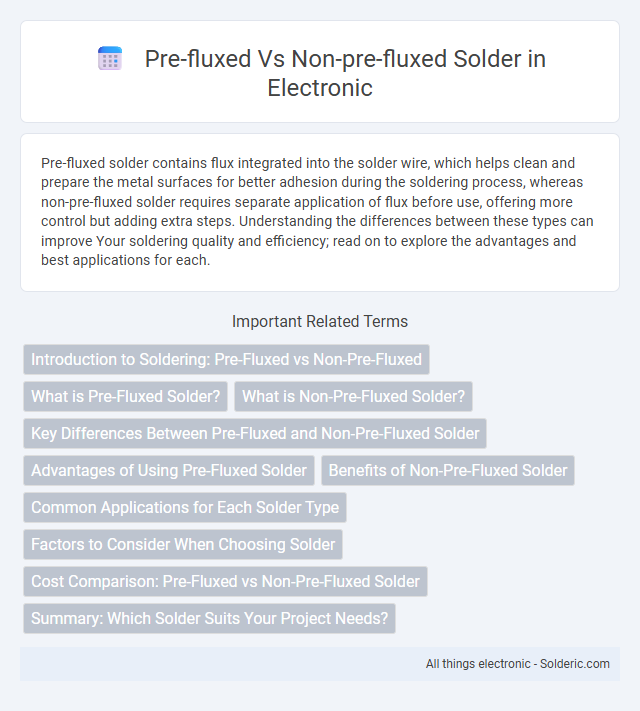Pre-fluxed solder contains flux integrated into the solder wire, which helps clean and prepare the metal surfaces for better adhesion during the soldering process, whereas non-pre-fluxed solder requires separate application of flux before use, offering more control but adding extra steps. Understanding the differences between these types can improve Your soldering quality and efficiency; read on to explore the advantages and best applications for each.
Comparison Table
| Feature | Pre-Fluxed Solder | Non-Pre-Fluxed Solder |
|---|---|---|
| Flux Application | Integrated within solder wire or paste | Requires separate flux application |
| Ease of Use | Simplifies soldering process | More preparation needed |
| Oxide Removal | Effective immediate oxide cleaning | Depends on separate flux quality |
| Residue | Minimal or no residue with no-clean type | Residue varies based on flux type used |
| Cost | Usually higher per unit cost | Lower cost per solder, but extra flux cost |
| Application | Ideal for quick repairs and hobbyist work | Preferred for professional, precise soldering |
Introduction to Soldering: Pre-Fluxed vs Non-Pre-Fluxed
Pre-fluxed solder contains flux embedded within the solder core, enhancing wetting and reducing oxidation during the soldering process, making it ideal for quick and clean joints. Non-pre-fluxed solder requires separate application of flux, offering more control over the type and amount of flux used, which is beneficial for complex or sensitive electronics work. Choosing between pre-fluxed and non-pre-fluxed solder depends on specific project requirements, such as component sensitivity and desired precision in solder joints.
What is Pre-Fluxed Solder?
Pre-fluxed solder contains a built-in flux core that facilitates the cleaning of oxide layers on metal surfaces during soldering, improving the bond quality and reducing oxidation without the need for separate flux application. Non-pre-fluxed solder requires the manual application of flux before soldering, which can increase preparation time and the risk of insufficient cleaning, leading to weaker joints. Understanding the role of pre-fluxed solder helps you streamline your soldering process and achieve more reliable, precise connections.
What is Non-Pre-Fluxed Solder?
Non-pre-fluxed solder is a type of solder wire or bar that does not contain any flux core or coating within or on its surface. This solder requires an external flux application during the soldering process to facilitate oxidation removal and improve metal wetting. Non-pre-fluxed solder is commonly used in applications where precise control over flux type and amount is necessary, such as in electronics assembly or plumbing.
Key Differences Between Pre-Fluxed and Non-Pre-Fluxed Solder
Pre-fluxed solder contains a flux core that facilitates the soldering process by cleaning and preventing oxidation on metal surfaces, enhancing joint quality and reducing the need for separate flux application. Non-pre-fluxed solder requires an external flux to be applied manually, which can increase preparation time and the risk of inconsistent flux distribution. Choosing between pre-fluxed and non-pre-fluxed solder depends on the specific application, precision requirements, and workflow efficiency.
Advantages of Using Pre-Fluxed Solder
Pre-fluxed solder offers significant advantages by integrating flux directly into the solder core, leading to faster and cleaner soldering processes. This type reduces the need for separate flux application, minimizing contamination and improving joint reliability for your electronic assemblies. Using pre-fluxed solder also enhances efficiency by shortening production time and ensuring consistent flux distribution in every solder joint.
Benefits of Non-Pre-Fluxed Solder
Non-pre-fluxed solder offers enhanced control over the flux application, allowing users to select specific flux types tailored to particular soldering tasks, which improves joint reliability and cleanliness. It reduces the risk of flux-related residue and corrosion, as flux is applied only where necessary, minimizing contamination on sensitive components. This approach also provides flexibility in automated or manual soldering processes, enabling precise flux dosing that enhances overall solder joint quality and performance.
Common Applications for Each Solder Type
Pre-fluxed solder is commonly used in electronics assembly, especially for small components and delicate circuit boards where precise, clean solder joints are critical. Non-pre-fluxed solder is preferred in plumbing and mechanical applications where manual flux application allows better control over the soldering process on larger or more robust metal surfaces. Your choice depends on whether convenience and speed or flexibility and control are more important for the specific task at hand.
Factors to Consider When Choosing Solder
Choosing between pre-fluxed and non-pre-fluxed solder depends on factors such as ease of use, cleanliness, and application type. Pre-fluxed solder offers convenience by integrating flux directly within the solder, reducing preparation time and minimizing the risk of oxidation during soldering, which is ideal for small-scale or repair work. Non-pre-fluxed solder allows for greater control over flux application and is preferred in industrial or high-precision environments where specific flux characteristics and residue management are critical.
Cost Comparison: Pre-Fluxed vs Non-Pre-Fluxed Solder
Pre-fluxed solder typically incurs higher upfront costs due to the integrated flux, which simplifies the soldering process and reduces labor expenses. Non-pre-fluxed solder requires separate flux application, increasing overall material and handling costs but offering greater flexibility for specialized applications. Price variations depend on project scale, with pre-fluxed solder often providing cost savings in mass production, while non-pre-fluxed solder remains economical for precision or repair work.
Summary: Which Solder Suits Your Project Needs?
Pre-fluxed solder contains an integrated flux core that simplifies the soldering process by cleaning and preparing metal surfaces, making it ideal for quick repairs and small-scale electronics projects. Non-pre-fluxed solder requires external flux application, offering greater control over the flux type and amount for precision work or specialized applications like aerospace or medical devices. Selecting the right solder depends on project complexity, required cleanliness, and whether ease of use or customization is prioritized.
pre-fluxed vs non-pre-fluxed solder Infographic

 solderic.com
solderic.com